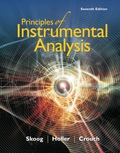
Principles of Instrumental Analysis
7th Edition
ISBN: 9781337468039
Author: Skoog
Publisher: Cengage
expand_more
expand_more
format_list_bulleted
Concept explainers
Question
Chapter 6, Problem 6.18QAP
Interpretation Introduction
Interpretation:
The concentration required for the 0.196 transmittance to be increased by factor 3 when a 1 cm cell was used should be determined.
Concept introduction:
The percent of light passing through the sample can be reported in a transmittance. In order to calculate the percent transmittance, the transmittance is multiplied by 100.
Expert Solution & Answer
Trending nowThis is a popular solution!

Students have asked these similar questions
If possible, replace an H atom on the
a carbon of the molecule in the
drawing area with a methyl group
substituent, and replace an H atom
on the ẞ carbon with a hydroxyl
group substituent.
If one of the substituents can't be
added for any reason, just don't add
it. If neither substituent can be
added, check the box under the
drawing area.
en
HO
OH
Curved arrows are used to illustrate the flow of electrons. Use
the reaction conditions provided and follow the curved arrows
to draw the intermediate and product of this
hydrohalogenation reaction.
Include all lone pairs and charges as appropriate.
Br
Select to Draw
51°F
Sunny
esc
F1
HBr
Select to Draw
1,2-hydride
shift
Br
Select to Draw
Q Search
F2
F3
F4
1
2
#
#
3
DII
L
F5
F6
F
tA
$
%
Λ
please help i cant find the article to even start
Chapter 6 Solutions
Principles of Instrumental Analysis
Ch. 6 - Prob. 6.1QAPCh. 6 - Calculate the frequency in hertz, the energy in...Ch. 6 - Calculate the frequency in hertz, the wavelength...Ch. 6 - Prob. 6.4QAPCh. 6 - Prob. 6.5QAPCh. 6 - Prob. 6.6QAPCh. 6 - What is the wavelength of a photon that has three...Ch. 6 - The silver bromide bond energy is approximately...Ch. 6 - Cesium is used extensively in photocells and in...Ch. 6 - Prob. 6.10QAP
Knowledge Booster
Learn more about
Need a deep-dive on the concept behind this application? Look no further. Learn more about this topic, chemistry and related others by exploring similar questions and additional content below.Similar questions
- What are the missing reagents for the spots labeled 1 and 3? Please give a detailed explanation and include the drawings and show how the synthesis proceeds with the reagents.arrow_forwardhelp with the rf values i am so confusedarrow_forwardPredict the organic reactant of X and Y that are involved in the reaction below, and draw the skeletal ("line") structures of the missing organic reactant. Please include all steps & drawings & explanations.arrow_forward
- What are the missing reagents for the spots labeled 1 and 3? Please give a detailed explanation and include the drawings and show how the synthesis proceeds with the reagents.arrow_forwardPlease provide the complete mechanism for the reaction below and include all appropriate arrows, formal charges, and intermediates. Please draw out the answerarrow_forwardPredict the major organic product for this reaction.arrow_forward
- help me with the rf value i am so confusedarrow_forwardPredict the major organic product for this reaction.arrow_forward3) The following molecule, chloral is a common precursor to chloral hydrate, an acetal type molecule that was a first-generation anesthetic. Draw a mechanism that accounts for tis formation and speculate why it does not require the use of an acid catalyst, like most hemiacetal and acetal reaction: (10 pts) H H₂Oarrow_forward
arrow_back_ios
SEE MORE QUESTIONS
arrow_forward_ios
Recommended textbooks for you
 Principles of Instrumental AnalysisChemistryISBN:9781305577213Author:Douglas A. Skoog, F. James Holler, Stanley R. CrouchPublisher:Cengage Learning
Principles of Instrumental AnalysisChemistryISBN:9781305577213Author:Douglas A. Skoog, F. James Holler, Stanley R. CrouchPublisher:Cengage Learning Principles of Modern ChemistryChemistryISBN:9781305079113Author:David W. Oxtoby, H. Pat Gillis, Laurie J. ButlerPublisher:Cengage Learning
Principles of Modern ChemistryChemistryISBN:9781305079113Author:David W. Oxtoby, H. Pat Gillis, Laurie J. ButlerPublisher:Cengage Learning

Principles of Instrumental Analysis
Chemistry
ISBN:9781305577213
Author:Douglas A. Skoog, F. James Holler, Stanley R. Crouch
Publisher:Cengage Learning

Principles of Modern Chemistry
Chemistry
ISBN:9781305079113
Author:David W. Oxtoby, H. Pat Gillis, Laurie J. Butler
Publisher:Cengage Learning
